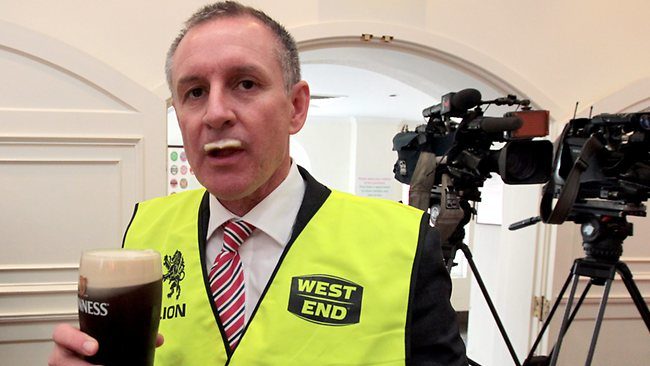
© Hispanic Political Caucus
If what Australia's political brains trust has done to its once reliable and affordable power supply had been done by external agents, it would have been branded an act of terrorism.
The so-called 'wind power capital' of Australia,
South Australia has become an international laughing stock: statewide blackouts, routine load shedding and rocketing power prices might be enough, you would think, to make its Labor government see sense.
Far from it, it is now looking to spend $150 million on a giant battery that will return power to the grid and 'power' SA
for all of four minutes and to set up somewhere between
200 and 250 MW of diesel generation capacity to keep the lights on, whenever the wind stops blowing.
The absurdity of throwing $550 million at a perfectly avoidable problem, when Jay Weatherill had the option of paying a mere $30 million to Alinta to keep its coal-fired plant at Port Augusta reliably chugging away for years to come, is mind blowing.
The Australian's Chris Kenny spends his time in the
following piece (article below) looking for logic and reason. In relation to Australia's self-inflicted energy disaster, logic and reason left the building a long, long time ago.
How we sabotaged our energy market
The Australian
Chris Kenny
18 March 2017

© The Australian South Australia’s Saboteur-in-Chief has a thirst for destruction.
There is an inexplicable lack of clarity around the energy crisis even as politicians, business leaders and journalists discuss details of complex policies and proposals designed to correct it. And, worryingly, a shambles created by government intervention is prompting yet more intervention by way of so-called remedies.
The debate is confined by unspoken mutual agreement so that the main causes and most obvious solutions are not even discussed. This is the constrained world of political correctness taking hold in a crucial area of practical and vital economic policy.
It should be about cold hard facts: energy demand and supply; resource availability and exploitation; electricity generation and consumption; power prices and security. We should have dispassionate and frank discussions but instead facts are often ignored or denied.
Since South Australia's unprecedented statewide blackout in September last year, Labor Premier Jay Weatherill has steadfastly claimed there was nothing wrong with his state's energy policies or system. Defiantly unapologetic, he spoke about "two tornadoes ripping through" the state in what was "not simply a storm" but an "unprecedented weather event" and he castigated anyone pointing out his renewables-reliant grid was at fault. "This was a weather event," he protested, "this was not a renewable energy event."
Yet this week Weatherill unveiled a $550 million plan to boost state-based gas generation, increase gas supplies, reduce reliance on interstate interconnection and provide large-scale battery storage to try to prevent future blackouts and load shedding. He is spending more than half a billion dollars on a problem he said didn't exist.
Weatherill's plan is vastly more expensive — by a factor of at least 20 — than the proposal he rejected little more than a year ago: to keep the Northern coal-fired power station in operation. Had he done that the blackouts would not have occurred and the next couple of years would not look so risky as he tries to build more generation and faces more pressure on interstate supplies with the imminent closure of Hazelwood in Victoria.
The Premier has stuffed this so badly that he plans to bring 200MW of back-up diesel generators into SA next summer. What a shambles.
When the power catastrophe hit on September 28, anyone familiar with SA's energy system and policies knew immediately it was a consequence, at least indirectly, of Weatherill's renewable energy push. This was because the decisive event was the tripping of the main interconnector to Victoria.
The government's push for a 50 per cent renewable share undercut the commercial viability of coal and gas generation — as intended — forcing much of the state gas generation into mothballs and triggering the closure of the coal-fired generators. So for the periods when wind or solar weren't working, Weatherill's Labor had made the state hopelessly reliant on that interconnector.
Subsequent technical reports revealed the culpability to be even worse. Rather than being triggered by collapsing towers, the initial problems occurred when wind farms fell off the grid and the sudden drop in voltage tripped the interconnector. Then, with no baseload or synchronous power available to re-energise the grid, the state was stuck.
The wind push had created the vulnerability in the grid; wind unreliability triggered the blackouts before lines were even brought down; and wind energy was useless when it came to trying to restart the system. Weatherill had introduced Don Quixote to the Ancient Mariner — windmills, windmills everywhere but not a volt to link.
Now a range of federal and state interventions are floated to fix SA's problems and prevent them spreading east to the other National Electricity Market states. Apart from publicly funded gas generators and battery installations there are incentives for exploration, proposed changes to the NEM rules and Canberra's demands that gas producers allocate more of their resources for peak demand domestic generation.
Serious consideration is given to taxpayer support for a ''clean'' coal generation plant somewhere on the eastern seaboard and now Malcolm Turnbull has announced a $2 billion medium-term upgrade of the Snowy Mountains scheme to included pumped hydro storage, boosting output by more than 2000MW.
This is a dog's breakfast of interventions that can only make it even more difficult for private energy investors, except in subsidised renewables. Yet most of the public debate focuses on the individual merits of the various interventions — band-aids on band-aids. Only a handful of politicians and commentators raise the elephant in the room — the renewable energy target.
The renewable energy that now makes up more than 40 per cent of SA's electricity production, not to mention wind and solar projects in other states, has emerged under the RET. This federal scheme mandates and subsidises renewable energy to a target of 33,000GWh by 2020.
And it is only about half complete — a further $10bn of large-scale renewable energy investment will occur in the next three years.
[Note to Chris, no one believes that Australia's current LRET will be satisfied by 2020, or at all. The number of new renewable projects being constructed can be counted on one hand and the level of uncertainty is such that commercial finance is simply unavailable for new wind power projects. The inevitable result is the imposition of the shortfall penalty, which will soon start costing power consumers $1.5 billion annually and $20 billion over the life of the LRET (see
our post here)]
These costs will be met by energy consumers regardless of whether electricity demand increases (ie, regardless of whether the investment is needed).
Because renewable electricity is intermittent, this investment does not negate the need for other forms of power — baseload — which are required when the renewables go missing. The trouble is, all this has made baseload investment unbankable.
Canberra's bipartisan RET has been successful in underwriting renewable projects and helping to close down a series of major coal-fired power stations, but it acts as a disincentive for investment in baseload generation. Hence SA's dilemma — coal and gas have shut down because their continued operation is financially unviable and there is no incentive to invest in baseload upgrades or new plant to meet the demand that might or might not occur, depending on the vagaries of the wind.
Even the debate about gas availability isn't entirely frank. If gas generators were confident about the electricity market they would have locked away long-term contracts and secured their supplies. The RET has killed that certainty — it is no use committing to gas contracts when your electricity price is undercut as soon as the wind blows, leaving them as the bidders of last resort for our gas resources.
The Pelican Point gas plant in Adelaide, for instance, could soon reboot its second generator but only if adequate electricity contracts can be signed enabling it to enter into gas contracts. It hopes large customers might now be willing to pay a premium for security.
The Prime Minister has become fond of saying he wants a "technology-agnostic" approach to energy fixes. But the RET is the antithesis of this — it is a massively disruptive market intervention in favour of renewable technologies.
If the RET were scrapped tomorrow, energy companies would model demand projections and costs and invest in the plant and contracts required to meet demand. That process now is completely contaminated, especially with Labor promising to double the RET after 2020 and the Coalition refusing to say what it will do beyond that date.
[Note to Chris, the Large-Scale RET
operates until 2031; between 2020 and 2030 it requires retailers to purchase 33 million renewable energy certificates each year, worth $93 each, totalling $3 billion each year and $42 billion from now until the LRET expires in 2031.]
Without the RET, SA's coal-fired power stations would still be operating and Pelican Point would be running at full capacity. There might even have been more investment in new plant or upgrades to other gas-fired plants. Hundreds of people would still be in work, a statewide blackout would not have occurred, Adelaide Oval would not be looking to buy a back-up generator, power would be cheaper and a $550 million state energy rescue package would not be required.
Similar chaos awaits Victoria as it pursues a 40 per cent renewable target and Queensland as it chases 50 per cent. All NEM states are already suffering price and insecurity consequences that will escalate dramatically if Labor's 50 per cent national target is adopted.
The RET is the problem but both major parties have declared it sacrosanct. The only possible justification for having a RET is to reduce emissions and save the planet. Yet this is obviously not happening because our emissions reductions are internationally insignificant and global emissions continue to rise. This is economic self-harm for no environmental gain — the madness of gesture politics writ large.
Anyway, there are a million other ways to reduce emissions, if we need to.
The Australian
and if they don't catch fire that they also do. Regardless of the fact that two nuclear power plants, the first in Chernobyl the second in Fukushima have blown up we are going nuclear worldwide even if indeed it's risky. With power consumption hitting record levels every year we simply have no alternative.